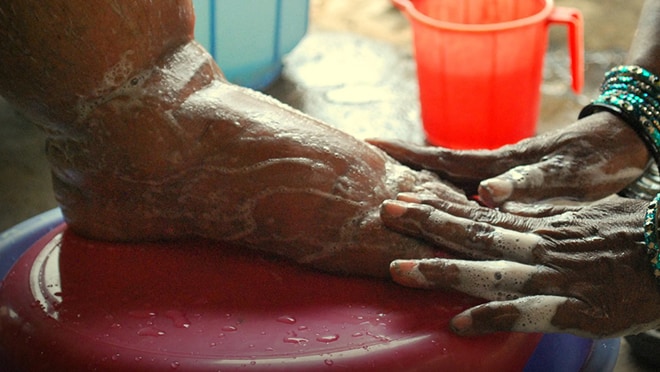At a glance
- Diethylcarbamazine citrate (DEC) is the drug of choice for lymphatic filariasis.
- Providers should refer patients with lymphedema to a therapist.
- Patients with hydrocele may need surgery.

Treatment options
Antiparasitic treatment
The main goal of treating a person with lymphatic filariasis is to kill the adult worm. Diethylcarbamazine citrate (DEC), which is both microfilaricidal and active against the adult worm, is the drug of choice for lymphatic filariasis. The late phase of chronic disease is not affected by antiparasitic treatment. Ivermectin is effective against the microfilariae of W. bancrofti but has no effect on the adult parasite.
Because lymphatic filariasis is rare in the United States, DEC is no longer approved by the U.S. Food and Drug Administration (FDA). Physicians can obtain the medication from CDC, after confirmed positive lab results.
Treatment of lymphatic filariasis in adults and children older than 18 months involves either a 1-day or 12-day treatment course of DEC (6mg/kg/day). One day treatment is generally as effective as the 12-day regimen.
For tropical pulmonary eosinophilia (TPE), a longer DEC treatment course of 14 – 21 days is generally recommended.
DEC is generally well tolerated. Side effects are limited and depend on the number of microfilariae in the blood. The most common side effects are dizziness, nausea, fever, headache, or pain in muscles or joints.
DEC is contraindicated in patients who may also have onchocerciasis. Prior to DEC treatment for lymphatic filariasis, onchocerciasis should be excluded in all patients with a consistent exposure history due to the possibility of severe exacerbations of skin and eye involvement (Mazzotti reaction).
In addition, DEC should be used with extreme caution in patients with circulating Loa loa microfilarial levels > 8,000/mm3 due to the potential for life-threatening side effects, including encephalopathy and renal failure. Neither steroids pre-treatment nor slow dose escalation prevents these complications. Consultation with a tropical medicine specialist is recommended in these scenarios.
The drug ivermectin kills only the microfilariae, but not the adult worm; the adult worm is responsible for the pathology of lymphedema and hydrocele.
Some studies have shown adult worm killing with treatment with doxycycline (200mg/day for 4 – 6 weeks).
Care for lymphedema and elephantiasis
Lymphedema and elephantiasis are not indications for DEC treatment. Most people with lymphedema are not actively infected with the filarial parasite, and lab tests are generally negative in these patients.
To prevent lymphedema from worsening, physicians should consider referring patients to a certified lymphedema therapist so they can be informed about basic principles of care, such as hygiene, exercise, elevation, treatment of wounds and infections, and use of appropriate footwear.
Complex decongestive physiotherapy can be effective for treating lymphedema. The National Lymphedema Network website lists certified lymphedema therapists and lymphedema organizations in the United States.
There is limited evidence to suggest that a 4 – 6-week course of doxycycline (200 mg/day) may stabilize or reverse the progression of disease in persons with lymphedema.
Treatment of hydrocele
The treatment for hydrocele is surgery (hydrocelectomy).
Patients with hydrocele may have evidence of active infection, but typically do not improve clinically following treatment with DEC. The treatment for hydrocele is surgery (hydrocelectomy).
For questions regarding diagnostic or treatment considerations, contact the Division of Parasitic Diseases and Malaria: parasites@cdc.gov. Diagnostic assistance is also available via DPDx.
